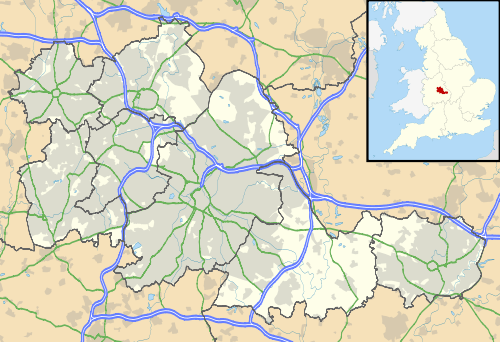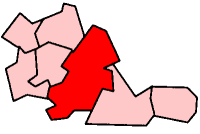Bordesley Green
| Bordesley Green | |
 South & City College Birmingham - Bordesley Green Campus |
|
 Bordesley Green |
|
| Population | 31,343 (2001 Population Census) |
|---|---|
| – density | 74.81 per ha |
| OS grid reference | SP105865 |
| Metropolitan borough | Birmingham |
| Metropolitan county | West Midlands |
| Region | West Midlands |
| Country | England |
| Sovereign state | United Kingdom |
| Post town | BIRMINGHAM |
| Postcode district | B9 |
| Dialling code | 0121 |
| Police | West Midlands |
| Fire | West Midlands |
| Ambulance | West Midlands |
| EU Parliament | West Midlands |
| UK Parliament | Birmingham Hodge Hill |
|
|
Coordinates: 52°28′34″N 1°50′38″W / 52.476°N 1.844°W
Bordesley Green is an inner-city area of Birmingham, England about two miles east of the city centre. It also contains a road of the same name. It is also a ward in the formal district of Hodge Hill. Neighbouring areas include, Alum Rock, Saltley, Small Heath and Yardley.
Heartlands Hospital is located in the eastern part of Bordesley Green. The area is also served by Yardley Green Medical Centre and Omnia Practice.
Kingfisher Country Park covers the River Cole recreation grounds which are partially covered by the area's boundaries.
Demography
The 2001 Population Census found that there were 31,343 people living in the ward. This makes it the second most populous ward, behind Sparkbrook.[1] The ward has an area of 417.7 hectares resulting in a population density of 74.81 people per hectare. This makes the ward the third densest ward, behind Sparkbrook and Lozells and East Handsworth.[2] Females represent 51.2% of the population, below the city average of 51.6% and the national average of 51.3%.
99.7% of residents lived in households, above the city average of 98.3%. The other 0.3% lived in communal establishments. The total number of occupied households in the ward was 9,350. This results in an average of number of people per household of 3.3, higher than the city of 2.5 and national average of 2.4. The majority of households are owner occupied (58%). 20.6% of occupied households are rented from Birmingham City Council, above the city average of 19.4%. 337 houses were identified as being vacant. Terraced houses built in the late 19th or early 20th century were the most common form of housing in the area at 54.4%, compared with the city average of 31.3% and the national average of 25.8%. At 25.4%, semi-detached houses were the second most common form of housing.
The area is an ethnically diverse community with ethnic minorities consisting of 71.1% of the population compared to 29.6% for Birmingham overall. 33.5% of the population was born outside of the United Kingdom, much higher than the city average of 16.5% and the national average of 9.3%. 62.2% of the population was of Asian origin, of which 50.5% were British Pakistanis. The proportion of Asian people in Birmingham is much lower at 19.5% and the proportion of Pakistani people is 10.6%. White British people represented 25.7% of the ward's population. There is a wide variety of languages spoken within the area such as Punjabi, Urdu, Mirpuri, Bengali, Pushto and Arabic with English being the most widely spoken language. The most dominant religion in the ward was Islam with 59.4% of the population stating themselves as Muslims, above the average for Birmingham of 14.3% and the national average of 3.1%. Christianity was the second largest religion in the ward with 27.1% of the ward's population stating themselves as Christians.
The ethnic minorities of Bordesley Green are particularly concentrated in the Victorian and Edwardian terraced houses, having emigrated to the area from the Commonwealth during the 1950s and 1960s.
The 25-44 age group represented the greatest portion of all age groups at 27.3%. At 22.2%, the 5-15 age group was the second largest. The proportion of the population that was of a pensionable age was 11.7%, below the city average of 16.7% and the national average of 18.4%. The proportion of people of a working age was 54.9%, below the city average of 59.8% and national average of 61.5%. The unemployment rate is 15.5%, higher than the city average of 9.5% and national average of 5%. 47.1% of the residents were identified as being economically active. Of the unemployed, 34.1% were in long term unemployment and 23.6% had never worked. 19.5% of the working population worked in the Wholesale & Retail Trade, Vehicle Repairs sector, followed by 19.3% of the working population working in the Manufacturing sector. The Birmingham Heartlands & Solihull Trust is the largest employer in the area, employing approximately 5,000 people. South Birmingham College is the second largest employer, employing around 850 people.[3]
Several hundred terraced houses around Bordesley Green dating from the late 19th and early 20th centuries were demolished in the early 1990s and new houses built on their site as part of a "New homes for old" initiative which allowed people to remain living in areas that their families had lived in for generations.
Politics
The Bordesley Green Ward was created in June 2004 out of the Small Heath and Sparkbrook wards. However the 2004 Council Election was marred by vote rigging by the Labour Party candidates, who were subsequently removed from the Council.
It is represented at the Birmingham City Council by two Liberal Democrat councillors and one Labour councillor; Zaker Choudhry (Liberal Democrats), Shaukat Ali Khan (Liberal Democrats) and Shafique Shah (Labour).
Bordesley Green has adopted a Ward Support Officer with the current holder of the title being Tracey Arthurs.
Bordesley Village
Bordesley Green has an associated village, Bordesley Village, within its ward, offering considerably better housing. The village is often referred as a separate area, and attempts are being made to separate the two to distinguish the areas. The village is also home to the City's football team, Birmingham City FC, built before the village was established from an old gypsy encampment and scrap yard. Recently, the village has seen several additions, becoming the hub of the city's new car sales, with premium firms such as Mercedes Benz, Audi & Infiniti, as well as Volkswagen & Seat and many more including motorcycle firms Heine Gericke & Triumph. The village is also served by several small shops, such as newsagents, a pharmacy and has its own dentist and doctors surgery. The village also caters for the needs of shoppers, offering a Morrisons supermarket & fuel station and Iceland, as well as fashion outlets such as JD, Bank, Topshop and other shops such as Toys R Us, Poundland, B&M and many more national companies within walking distance of the village.
The Village concept in Bordesley Green was the first "Ideal Village" in England, built between 1908 and 1914 by Barry Parker and Raymond Unwin. The pair eventually went on to build Welwyn Garden City in Hertfordshire. The villages were a welcome relief to English cities at the time and the homes were built to high standards.
Daniels Road in Bordesley Green commemorates schoolteacher Francis Daniels. Originally from Ebley near Stroud, Daniels came to Birmingham in 1891 and soon saw the need to provide affordable social security for ordinary working people. With the Lord Mayor, Alderman William Kendrick as president and Daniels himself as general secretary, the Ideal Society was formed.
By 1910 the society had moved into housing provision and commenced the building of the Ideal Village at Bordesley Green, where Finnemore Road also commemorates an early chairman of the society, William Finnemore. The first houses to be built were in Drummond Road. The village, which was designed for artisan workers, has shops, a park and a school and a much lower density of housing than the nearby terraces.
St Paul's Mission, built in 1912 in Finnemore Road as a chapel of St Margaret's Ward End, was consecrated as a parish church in 1929. A new church was built c1970 in Belchers Lane behind the old, which was retained as the church hall. The church is now the centre of a community project embracing a number of different facilities and services.
In 1998 children from Bordesley Green Primary School discovered the origin of a badly damaged stone fountain in the Ideal Park which commemorates the rescue by a local boy of a drowning girl. On 7 May 1907 16-year-old cycle polisher, Harold Clayfield of 11 Ronald Road, jumped into a 5m deep clay pit at the junction of Belchers Lane and Bordesley Green to save 4-year-old, Florence Jones. The girl was saved, but non-swimmer Clayfield, drowned. His memorial was paid for by public subscription. Sadly Florence herself was to die only four years later as a result of playing with burning pieces of paper at her home in Green Lane.[4]
Skate Park
Bordesley Green has one skate park, known locally as the Pod. It is popular with mini BMX Rocker riders.
Education
Primary schools
- Alston Junior and Infants Primary School
- Bordesley Green Junior and Infants Primary School
- Wyndcliffe Primary School
Secondary schools
Further education
- South and City College Birmingham - Bordesley Green Campus
Health
- Heartlands Hospital
- Yardley Green Medical Centre
- Omnia Practice
References
- ↑ Birmingham Economy: Population
- ↑ Birmingham Economy: Population Density
- ↑ Birmingham Economy: Bordesley Green
- ↑ "The Ideal Village". http://billdargue.jimdo.com. http://billdargue.jimdo.com. External link in
|publisher=, |work=(help)
- 2001 Population census information: Ward profiles
- small heath medical practice
- Birmingham City Council: Bordesley Green Ward

